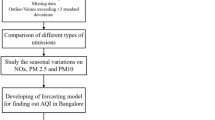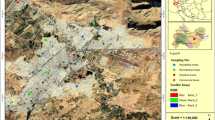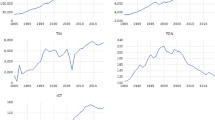Abstract
The Information Technology (IT) industry in the globalizing city of Bangalore has transformed the socio-economic characteristics of the city. The intent of this study, developed from an environmental justice framework, was to determine whether air pollutant exposure while commuting to and from work is related to a commuter’s income characteristics and whether differences are larger for the IT economy when compared with a traditional manufacturing-oriented economy of the city. The study measured exposures to CO and PM10 using personal samplers for a sample of employees of a traditional public sector manufacturing industry (n=20) and an IT industry (n=26). This approach overcomes the methodological limitations of previous environmental justice studies. Socio-economic characteristics were obtained from a questionnaire-based survey of 436 employees in two firms. The results do not support the environmental justice hypothesis for commuting in Bangalore mainly because longer commuting times of higher-income groups offsets the benefits of lower pollutant concentrations. The study nevertheless demonstrates the use of personal exposure for environmental justice assessments.
This is a preview of subscription content, access via your institution
Access options
Subscribe to this journal
Receive 6 print issues and online access
$259.00 per year
only $43.17 per issue
Buy this article
- Purchase on SpringerLink
- Instant access to full article PDF
Prices may be subject to local taxes which are calculated during checkout
Similar content being viewed by others
References
Kinney P Chapter 6. Environmental equity. WHO Air Quality Guidelines: Global update 2005. World Health Organization, European Center for Environment and Health, Bonn, Germany, 2005, pp. 135–147.
Lucier G, Schecter A . Human exposure assessment and the national toxicology program. Environ Health Perspect 1998; 106: 623–627.
Perlin SA, Sexton K, Wong DWS . An examination of race and poverty for populations living near industrial sources of air pollution. J Expo Anal Environ Epidemiol 1999; 9: 29–48.
Waller AL, Thomas LA, Carlin PB . Environmental justice and statistical summaries of differences in exposure distributions. J Expo Anal Environ Epidemiol 1999; 9: 56–65.
Sheppard E, Leitner H, McMaster RB, Tian H . GIS-based measures of environmental equity: exploring their sensitivity and significance. J Expo Anal Environ Epidemiol 1999; 9: 18–28.
Harner J, Warner K, Pierce J, Huber T . Urban environmental justice indices. Prof Geogr 2002; 54: 318–331.
Buzzelli M, Jerrett M, Burnett R, Finklestein N . Spatio-temporal perspectives on air pollution and environmental justice in Hamilton, Canada, 1985–1996. ANN Assoc Am Geogr 2003; 93: 557–573.
Mitchell G, Dorling D . An environmental justice analysis of British air quality. Environ Plann A 2003; 35: 909–929.
Noonan DS . Evidence of environmental justice: a critical perspective on the practice of EJ research and lessons for policy design. Soc Sci Quart 2008; 89: 1153–1174.
Liu F . Environmental Justice Analysis: Theories, Methods and Practice. CRC Press: Florida, USA. 2000.
Maantay J . Mapping environmental injustices: pitfalls and potential of geographic information systems in assessing environmental health and equity. Environ Health Perspect 2002; 110 (suppl 2): 161–171.
Buzzelli M . Bourdieu does environmental justice? Probing the linkages between population health and air pollution epidemiology. Health Place 2005; 9: 1–11.
Flachsbart PG . Human exposure to carbon monoxide from mobile sources. Chemosphere 1999; 1: 301–329.
Setton E, Marshall DJ, Brauer M, Lundquist RK, Hystad P, Keller P et al. The impact of daily mobility on exposure to traffic-related air pollution and health effect estimates. J Expo Sci Environ Epidemiol 2011; 21: 42–48.
Lateef A Linking up with the global economy: a case study of the Bangalore software industry. Geneva: International Institute for Labour Studies; 1997 New Industrial Organization Programme discussion paper DP/96/1997.
Benjamin S . Governance, economic settings and poverty in Bangalore. Environ Urban 2000; 12: 35–56.
Dittrich C . Bangalore: globalisation and fragmentation in India’s hightech-capitol. Asien 2007; 103: 45–58.
Madon S . Information-based global economy and socioeconomic development: the case of Bangalore. Inf Soc 1997; 13: 227–243.
Friedmann J, Wolff G . World city formation: an agenda for research and action. Int J Urban Reg Res 1982; 6: 309–344.
Audirac I . Information-age landscapes outside the developed world: Bangalore, India and Guadalajara, Mexico. J Am Plann Assoc 2003; 69: 16–32.
Sabapathy A, Flachsbart PF, Saksena S . Commuting patterns of employees in the Information Technology and traditional manufacturing sectors of Bangalore, India. Transport Policy 2012; 19: 155–166.
Cortese A, Spengler J . Ability of fixed monitoring stations to represent personal carbon monoxide exposure. J Air Pollut Control Assoc 1976; 26: 1144–1150.
Ott WR, Flachsbart P . Measurement of carbon monoxide concentrations in indoor and outdoor locations using personal exposure monitors. Environ Int 1982; 8: 295–304.
Akland G, Hartwell T, Johnson T, Whitmore R . Measuring human exposure to carbon monoxide in Washington, DC, and Denver, Colorado, during the winter of 1982-83. Environ Sci Technol 1985; 19: 911–918.
Dimitriou HT . Urban Transport Planning: A Developmental Approach. Routledge: London, UK. 1992.
Dimitriou HT . Transport Planning for Third World Cities. Routledge: London, UK. 1990.
Han X, Naeher LP . A review of traffic-related air pollution exposure assessment studies in the developing world. Environ Int 2006; 32: 106–120.
Sabapathy A, Ragavan KVS, Saksena S . An assessment of two-wheeler CO and PM10 exposures along arterial main roads in Bangalore city, India. Open Atmos Sci J 2012; 6: 71–77.
Lioy PJ . Assessing total human exposure to contaminants. Environ Sci Technol 1990; 24: 938–945.
Ott WR . Total human exposure: an emerging science focuses on humans as receptors of environmental pollution. Environ Sci Technol 1985; 19: 880–886.
Saksena S, Prasad RK, Shankar VR . Daily exposure to air pollutants in indoor, outdoor and in-vehicle micro-environments: a pilot study in Delhi. Indoor Built Environ 2007; 16: 39–46.
McLeod H, Langford IH, Jones AP, Stedman JR, Day JR, Lorenzoni I et al. The relationship between socio-economic indicators and air pollution in England and Wales: implications for environmental justice. Regional Environ Change 2000; 1: 78–85.
Acknowledgements
The lead author gratefully acknowledges the research grant and the exposure-monitoring equipment provided by the East West Center in Honolulu to perform the field work related to the study. This manuscript was prepared during the lead author’s Fulbright–Nehru Environmental Leadership Program supported by the United States–India Educational Foundation.
Author information
Authors and Affiliations
Corresponding author
Ethics declarations
Competing interests
The authors declare no conflict of interest.
Rights and permissions
About this article
Cite this article
Sabapathy, A., Saksena, S. & Flachsbart, P. Environmental justice in the context of commuters’ exposure to CO and PM10 in Bangalore, India. J Expo Sci Environ Epidemiol 25, 200–207 (2015). https://doi.org/10.1038/jes.2014.34
Received:
Accepted:
Published:
Issue date:
DOI: https://doi.org/10.1038/jes.2014.34
Keywords
This article is cited by
-
Long-term exposure to high particulate matter pollution and incident hypertension: a 12-year cohort study in northern China
Journal of Human Hypertension (2021)



